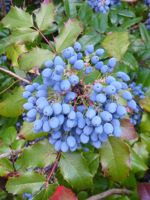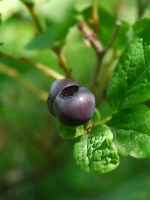Mon-Fri 9am - 5pm Mountain time
Oregon Grape vs Mountain Huckleberry
Mahonia aquifolium (Berberis aquifolium)
Vaccinium membranaceum
NOT AVAILABLE THIS SEASON - MIGHT RETURN
NOT AVAILABLE THIS SEASON - MIGHT RETURN
Oregon Grape is an evergreen shrub native to North America, found along the Pacific coast. In spring, the bright golden-yellow flowers appear in clusters above the leaves. These flowers eventually give way to edible blue berries in late summer. While not a true grape, the berries appear grape-like due to their colouring and clustered growth. They can be eaten fresh, but the sour taste and high amounts of natural pectin make them well suited for preserves.
The Oregon Grape has leaves that are glossy, leathery, and spiny-edged. This feature gives it its alternate name of Holly-leaved Barberry. When the leaves emerge in the spring they are a bronze-red colour. In the summer they transition to green, followed by bright red to deep burgundy in the fall. Leaves are retained throughout the winter and colder temperatures cause the leaves to turn purplish bronze, providing year round interest to the landscape.
Mountain Huckleberry is a small shrub known for its tart to sweet berries. The berries range from purple-black to red-black, and can be eaten fresh or used in jams and syrups. It is a plant native to Alberta and the berries are frequently enjoyed by both people and wildlife.
In traditional Indigenous fire management practices, berry patches were burned after harvest. This would reduce the invasion of other plants allowing the Mountain Huckleberry to thrive. Its foliage has low flammability and can survive low severity fires, and even if destroyed they regrow from the roots.
Note: Mountain Huckleberry requires specific soil conditions. They need moist, well-drained, acidic soil with a pH around 5.5.

